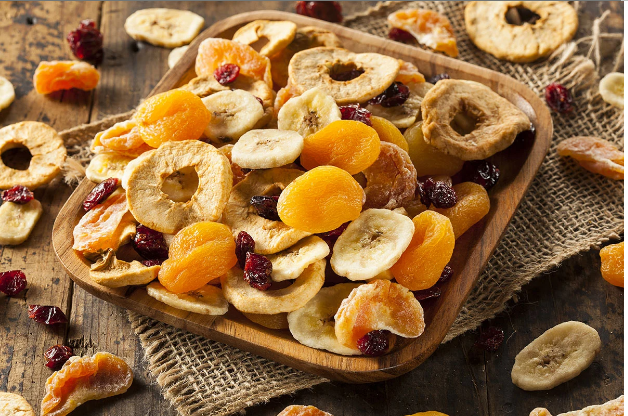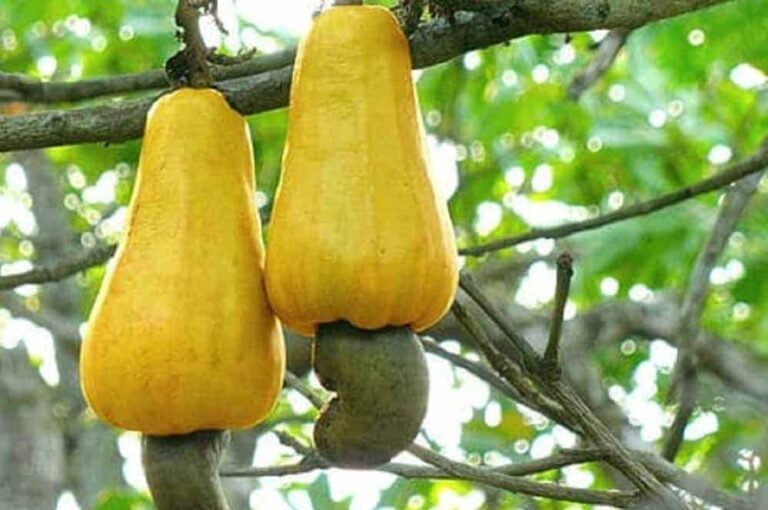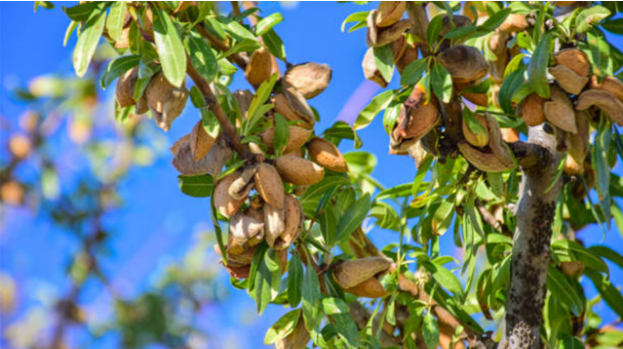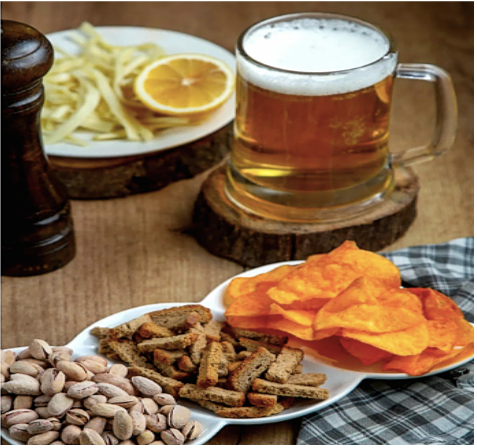Your cart is currently empty!
The Complete History Of Pesto
Pestos, pastes, and purées are ancient recipes made around the world with greens and herbs, garlic and spices.com nuts, oils, and other ingredients depending on a country’s agriculture and cuisine. Today, chefs and cooks every creating pestos from spinach, kale, arugula, peppers, tomato, and whatever else they are growing in their kitchen gardens. in containers on decks and patios, and indoors in hydroponic gardens. Certainly, pesto has seen an increase in interest since the start of the 21st Century.
The History Of Pesto Starts In Italy
One of the most familiar pestos originated in Genoa, Italy, in the province of Liguria. Made from basil, pine nuts, garlic, olive oil, Parmigiano-Reggiano, and/or Pecorino Romano cheeses, Pesto Genovese is a traditional Italian sauce for dressing pasta. It is also delicious with fish, meats, vegetables, soups, and bread.
Basil was introduced to Mediterranean countries via the ancient spice routes from India. It was possibly used by the Romans, who ground a mixture of herbs, cheese, and garlic into a paste called moretum. Italians in Liguria adapted the Roman cheese and garlic dish to include basil and pine nuts. Liguria grows these ingredients naturally on their hillsides. Using their local olive oil, they ground everything together into pesta, which comes from pestare, meaning “to pound or crush in a mortar with a pestle”. In 1863, Giovanni Battista Ratto provided what is believed to be the first modern recipe or pesto. It remains today in the known origin of pesto from his book, La Cuciniera Genovese.

Pesto is very regional in Italy. In Calabria, pesto alla calabrese consists of roasted bell peppers, garlic, black pepper, basil, cheese, and olive oil. The origin of Pesto Rosso, from Sicily, is red from the addition of tomatoes and from using just a little basil. Gremolata or gremolada is a thick paste made from chopped parsley, lemon zest, and garlic, sometimes with the addition of olive oil, breadcrumbs, anchovies, and Pecorino Romano cheese. It is the traditional accompaniment to osso buco alla Milanese (braised veal shank, although lamb shanks are interchangeable).
OUT OF ITALY
Other countries have their own version of pesto. In nearby Provence, the French version is pistou, a combination of basil, parsley, crushed garlic, and grated cheese. Pistou is used as an accompaniment to soupe au pistou, a hearty vegetable soup not unlike the Italian minestrone soup, which is also often adorned with pesto. This French soup has such a close spelling and name to the sauce we all use today, that it is the root of a modern history of pesto.
Spain has romesco, which is a red paste of romesco chile peppers processed with tomatoes, sweet red peppers, pine nuts, garlic, and olive oil. The Germans make a pesto from the flat elliptical leaves of ramsons, a wild garlic that grows rampantly in moist pastures in many European countries and in southern regions of the United States.
The Origin Of Pesto In Peru
In Peru, there is a dish called tallarines verdes or “green noodles” after Italian tagliarini pasta with green pesto. The green color is enhanced by the inclusion of spinach. They may use vegetable oil instead of olive oil and other nuts in place of expensive and imported pine nuts.
In the nineteenth century, Genovese immigrants to Argentina introduce pesto recipes to their new homeland, where chimichurri evolved in the of chopped parsley, oregano, garlic, olive oil, and wine vinegar. In Brazil, the Portuguese have a paste called tempero, which they use as a basic seasoning for many cooked dishes. Tempero combines onions, leeks, garlic, basil, and parsley with a large quantity of salt but no oil. The salt allows the paste to keep under refrigeration for at least one year.
The Creation Of Singapore Laksa Pesto
In Singapore, an Italian-Peranakan version is called Laksa pesto, which includes curry. Anyone who loves Indian food and chicken have surely ordered tandoori chicken. Tandoori paste is a blend of curry spices, onion, garlic, chiles, ginger, and yogurt. Thailand is famous for its red and green curry pastes. The ingredients for both are almost identical except for the hot red chiles while the green contains spicy green chiles. Harissa paste, a fiery Mediterranean variation in the history of pesto, is made with mint, parsley, cilantro, garlic, olive oil, and dried cayenne peppers. In North Africa, unlike French and Italian pestos, harissa does not contain nuts or cheese.
In most Thai and Mexican restaurants, you will find some kind of thick sauce containing peanuts or almonds, sesame or pumpkin seeds, peppers, garlic, and oil. No cheeses or basil. Mexican pipian is a ground or puréed mole sauce. Containing vegetable oil, onions, pumpkin seeds (pepitas), peanuts, sesame seeds, chile peppers, garlic, spices, and herbs. It is a traditional condiment or marinade for chicken, pork, seafood, and vegetable dishes.
Pipian verde, a green variety, contains tomatillos and green peppers. When not diluted with too much liquid, the result is a thick pesto-like sauce. Also, like any pesto or paste, pipian can be used as a rub for meats. It has been found to create a crust that helps seal in the juices. Like Italian pesto, you can find Mexican moles in some supermarkets. Both are at their best when made fresh.
A PESTO IS A PASTE IS A PURÉE
It all comes down to the fact that depending on the country, the region, and the cook, a pesto could be a paste or will be a purée. It’s just a matter of how much liquid you add to the mixture. That liquid could be oil or vinegar, fermented fish sauce or soy sauce, juice or broth, or even water. The beauty of the history of pestos, pastes, and purées is that they are easy to make by people that are not professional chefs. Throw fresh herbs with garlic. spices, oil, and some cheese or tofu into a food processor and you have a quick topping for pizza, pasta, couscous, fish, chicken, or whatever you fancy. Sweet pestos are just as easy and make a delicious and unusual accompaniment to pancakes, tarts, pastries, waffles, and ice cream.
THE BASIC INGREDIENTS | NOT A RECIPE. JUST A SUGGESTION.
Greens and Herbs
In a traditional pesto recipe, you can substitute one, two, or even three cups of different greens and/or herbs for the same amount of sweet basil leaves. Experiment with combinations of arugula, spinach, baby kale, tender chard, mint, tarragon, bronze fennel, cilantro, lemon basil, Thai basil, thyme, scallion greens, chives, sage, oregano, or rosemary.
Cheese
You can use hard-grating cheeses, such as Asiago, Pecorino Romano, Cotija, Manchego, aged Gouda, or aged cheddar. Used in place of Parmesan (Parmigiano-Reggiano or Grana-Padano).
Oil
Olive oil is a great flavor enhancer as well as considered one of the best oils on the planet. You can also find recipes with grape seed and canola oils pressed so as not extracted with chemicals and heat. The fewer oils used the creamier the pesto will taste. You can reduce the quantity of oil by substituting up to half the amount with nut milk. For the most part, nut milks will not add a strong flavor.
Garlic
Besides adding a powerful burst of taste, garlic contains allicin and diallyl sulfides. Both of these elements have a medical endorsement as being effective in the management of blood pressure and cholesterol levels. Older bulbs lose their firmness and are not as strong or spicy. If garlic is young and beginning to sprout, you can split them in half and zip out the green germ.
Nuts
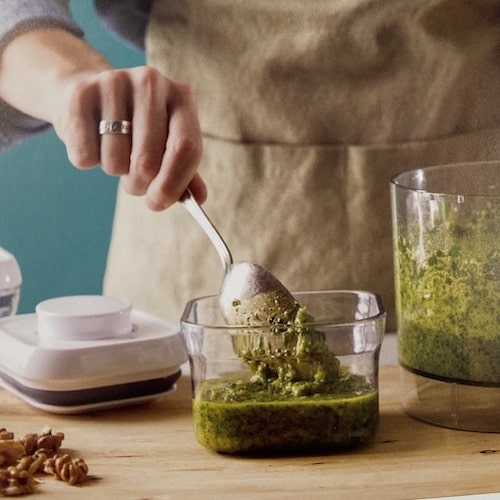
Some nuts taste good when raw. Others improve with a little toasting. like to use unroasted walnuts, almonds, pecans, pine nuts, and hazelnuts, refer to roast sunflower seeds, pumpkin seeds, cashews, pistachios, and peanuts. They are just more delicious when roasted. Fortunately, you can buy them already roasted. If you add too much salt then cut back on the salt added to other ingredients in your pesto recipe.
Salt And Pepper
Salt and pepper are important additions, but the amount you add is up to you. Some like to use coarse sea salt and whole black pepper freshly milled. Subsequently, it’s easy to grind the salt and pepper right inside of the food processor after the other ingredients.
ENHANCING AND BRIGHTENING FLAVORS
Sometimes when you taste your finished pesto, paste, or purée, your taste buds may want a little something extra. In a taste test, find a partner to tell you if what you are making needs more salt or needs less citrus. Maybe the recipe needs some more vinegar or a little more sweetness. Alternatively, brighten the flavor with a little lemon or lime juice before adding more salt. Or lift up the acidity with a little honey, which tempers the flavor without having to add more oil. A tablespoon or two of water also lightens or thins without changing the flavor.
STORING EXTRA QUANTITIES
Recipes containing oils and vinegar can, as a rule, have storage in jars in the refrigerator for at least two weeks. The history of pesto includes the ingredients of greens, herbs, oils, garlic, nuts, and cheeses that can be frozen. Spoon two to four tablespoons into small plastic containers with tight-fitting lids. Frozen pesto will remain fresh for up to six months. You can thaw it in the refrigerator overnight or at room temperature in about two hours or less. Small quantities like this defrost quickly and are convenient to add to individual pasta servings. Or added to any recipe that would benefit from fresh herbal flavors.
A WORD ABOUT EQUIPMENT
Most chefs and home cooks have embraced food processors. Really, the ease with which a chef can slice, dice, and purée, any kind of food in just a matter of minutes. A food processor may lack the Zen quality in the preparation of food. But, you can still control the resulting texture of food ranging from chunky to smooth. However, some old-school chefs and cooks prefer to use mortar and pestle.
The Traditional Mortar and Pestle
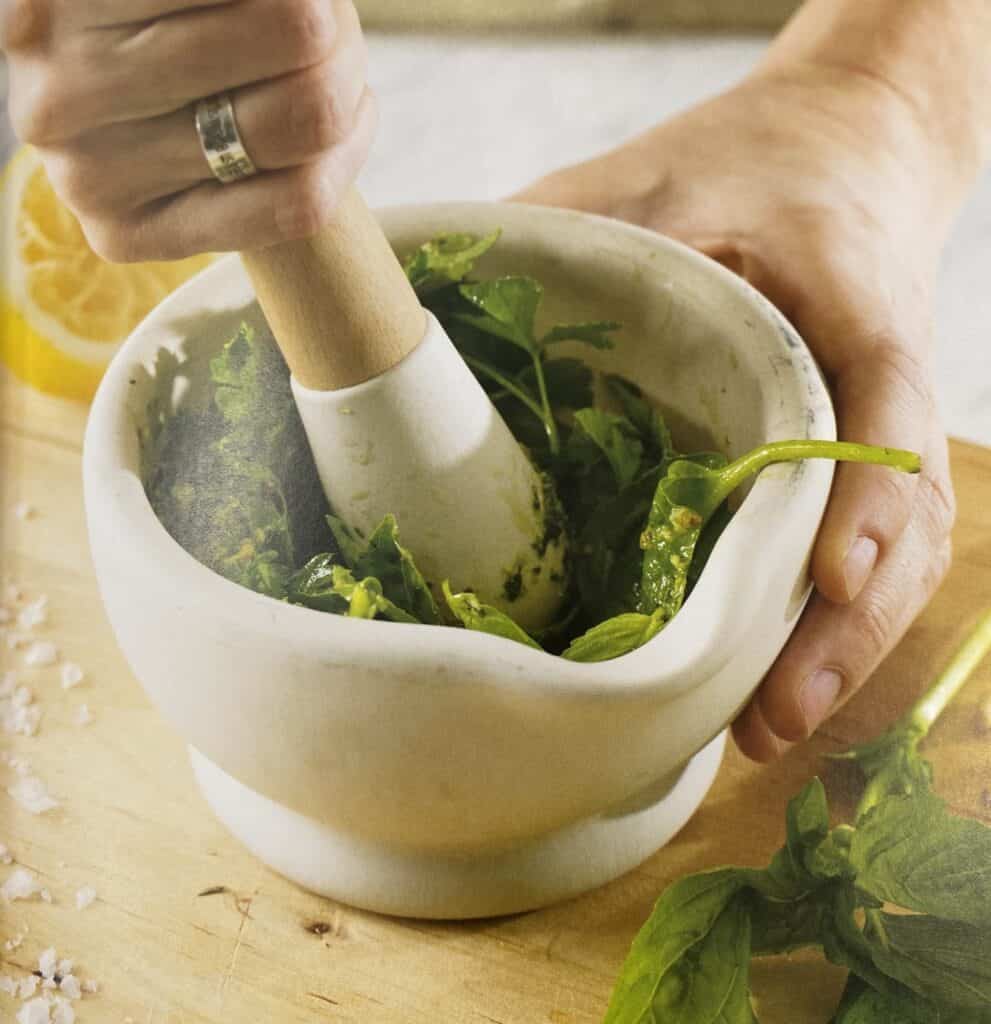
Made from granite, marble, rock, earthenware, and even wood, the mortar is one of the most primitive tools that find use in crushing various foods and seasonings. The ingredients are placed in the mortar bowl and are ground with a small club-shaped pestle. The mortar and pestle have a wide range of use in different cultures. Starting with the rustic stone, called a Krok, used to make the dish, Thai Coconut Pancakes. The Mortar And Pestle have a specific use to pulverize spices and fibrous ingredients. All the ingredients are common in Thai cuisine. Across the world, there is a rough Mexican version of making Pipián. Pipián, also known as a green mole, is a sauce from Mexican cuisine made with pureed greens and thickened with ground pumpkin seeds. Both pieces of the Krok are traditionally hand-carved with a hammer and chisel from a solid piece of nonporous granite.
The Use Of Mortar) And Pestle In Mexico
The Mexican molcajete (mortar) and tejolote (pestle) are made from porous black volcanic rock. The process of making the Mexican molcajete and tejolote is that it will start with soaking in water, then a drying process, and finally a covering in seasons including salt and spices. Then it is ready for use. Granite and marble are particular to grinding fibrous and strong-flavored ingredients because these hard stones don’t absorb flavors. The more irregular surface of granite is better than the smooth surface of the marble. Marble is so smooth that it doesn’t grab the herbs and other ingredients, thus making for a crushing texture. In some Mediterranean countries, it is the ceramic clay bowls that they use.
However, mortars made from a pottery are not as heavy or resistant to pounding as marble and granite. The ceramic Suribachi and wooden surikogi find used to prepare traditional Japanese food. The mortar is made from fired earthenware, which is glazed on the outside and ridged on the inside. Therefore, the ridges make it much easier to grind sesame seeds and other ingredients. Using a wooden pestle doesn’t wear down the ridges or crack the bowl.
Food Processors
Any recipe can be made using the traditional mortar-and-pestle method. However, in the modern era, using a food processor for basil and other greens is the easiest option. Some food processors will do a better job of chopping the garlic with salt before the rest of the ingredients are added. Once you understand the vagaries of your food processor, you can adjust your mixing methods.


